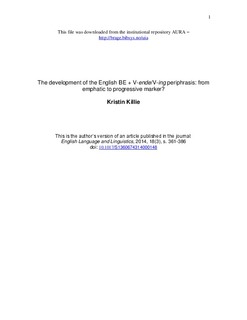| dc.contributor.author | Killie, Kristin | |
| dc.date.accessioned | 2015-01-22T12:33:24Z | |
| dc.date.available | 2015-01-22T12:33:24Z | |
| dc.date.issued | 2014 | |
| dc.identifier.citation | Killie, K. (2014). The development of the English BE + V-ende/V-ing periphrasis : from emphatic to progressive marker? English Language and Linguistics, 18(3), 361-386. doi: 10.1017/S1360674314000148 | nb_NO |
| dc.identifier.issn | 1360-6743 | |
| dc.identifier.uri | http://hdl.handle.net/11250/274570 | |
| dc.description | Author's version of an article in the journal: English Language and Linguistics. Also available from the publisher at: http://dx.doi.org/10.1017/S1360674314000148 | nb_NO |
| dc.description.abstract | The article discusses the grammaticalization of the be + V-ende/V-ing periphrasis as a progressive marker. On the basis of quantitative data, it is claimed that the periphrasis started out as an emphatic alternative to the simple tenses. Its length, unusualness and optionality made it well suited as an emphatic marker. In the Early Modern English period (c. 1500–1700), the periphrasis was reinterpreted as an emphatic progressive marker. The prototypical – so-called focalized – use of the construction gradually became obligatory (from the nineteenth century onwards). This caused the focalized use of the periphrasis to lose its emphasis, while the so-called durative use of the construction has remained optional and emphatic to this day, like the subjective uses of the periphrasis. The article also explores the question of influence from Latin on the periphrasis in the Old English period (i.e. up to c. 1100), concluding that any such influence is likely to have consisted in a reinforcing effect. | nb_NO |
| dc.language.iso | eng | nb_NO |
| dc.publisher | Cambridge University Press | nb_NO |
| dc.title | The development of the English BE + V-ende/V-ing periphrasis : from emphatic to progressive marker? | nb_NO |
| dc.type | Journal article | nb_NO |
| dc.type | Peer reviewed | nb_NO |
| dc.subject.nsi | VDP::Humanities: 000::Linguistics: 010 | nb_NO |
| dc.source.pagenumber | 361-386 | nb_NO |
| dc.source.volume | 18 | nb_NO |
| dc.source.journal | English Language and Linguistics | nb_NO |
| dc.source.issue | 3 | nb_NO |
| dc.identifier.doi | 10.1017/S1360674314000148 | |
